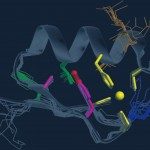Link to Pubmed [PMID] – 29878408
Link to DOI – 10.1002/chem.201801701
Chemistry 2018 Aug; 24(48): 12638-12651
Six novel probes were prepared by covalent attachment of a G4-DNA ligand (bis(quinolinium) pyridodicarboxamide; PDC) to various coumarin or pyrene fluorophores. In the absence of DNA, the fluorescence of all probes is quenched due to intramolecular photoinduced electron transfer (PET), as evidenced by photophysical and electrochemical studies, molecular modeling, and DFT calculations. All probes demonstrate similarly high thermal stabilization of various G4-DNA substrates belonging to different folding topologies, as assessed by fluorescence melting experiments; however, their fluorimetric response is strongly heterogeneous with respect to the structures of the probes and G4-DNA targets. Thus, the probes containing the 7-diethylaminocoumarin fluorophore demonstrate significant fluorescence enhancement in the presence of G4-DNA, with the strongest “light-up” response (20- to 180-fold) observed for antiparallel G4 structures as well as for hybrid G4 structures, formed by the variants of human telomeric sequence and capable of a conformation change to the antiparallel isoform. These results shed light on the influence of the linker and electronic properties of fluorophores on the efficiency of G4-DNA “light-up” probes operating via PET.
